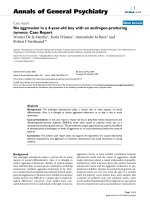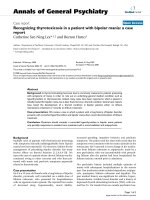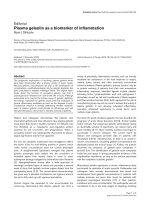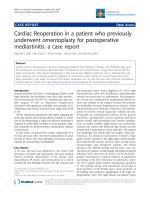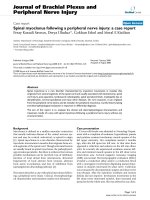Báo cáo y học: "Neurology Case Reporting: a call for all" doc
Bạn đang xem bản rút gọn của tài liệu. Xem và tải ngay bản đầy đủ của tài liệu tại đây (213.25 KB, 2 trang )
EDI T O R I A L Open Access
Neurology Case Reporting: a call for all
Richard A Rison
Abstract
From antiquity to present day, the act of recording and publishing our observations with patients remains essential
to the art of medicine and the care of patients. Neurology is rich with case reports over the centuries. They
contribute to our understanding and knowledge of disease entities, and are a cornerstone of our professional
development as physicians and the care of our patients. This editorial seeks to enthuse and invigorate house staff
and practicing physicians everywhere to continue the long and time-honored tradition of neurology case
reporting.
Neurology Case Reporting: A call for all
“If thou examinest a man having a wound in his temple,
penetrating to the bone, (and) perforating his temporal
bone; if thou ask of him concerning his malady and he
speak not to thee; while copious tears fall from both his
eyes, so that he thrusts his hand often to his face so that
he may wipe both his eyes with the back of his hand ”
Edwin Smith surgical papyrus,
Case 20, c2800 BC [1]
From the earliest description of aphasia by an Egyp-
tian surgeon over 4000 years ago [1], to Journal of Med-
ical Case Reports’ (JMCR) latest neurological publication
on videofluoroscopy in a patient with dysphagia as the
initial presentation of myasthenia gravis currentl y pub-
lished around the time of this writing [2], case reports
have been a time-honored tradition in the neurological
sciences. From daily interactions with experienced col-
leagues and caring for our individual patients, physicians
continue to build a clinical knowledge base. This acu-
menmustbepassedonthroughoutthegenerationsto
better patient care. There is no better enduring method
for this than the act of publication.
From antiquity to present day, the act of recording
and publishing our observations with patients remains
essential to the art of medicine and t he care of patients.
Osler stated “ Always note and record the unusual
Publish it. Place it on permanent record as a short, con-
cise note. Such communications are always of value.”
[3]. If we as clinicians are to know where we are headed
and improve the care of the people charged to us, then
we must know the past and where our predecessors
have been. Case reports and history are essential dimen-
sions. The past allows us to enlighten our perspective of
the present and the future. As Osler so eloquently said:
“The past is always with us, never to be escaped; it alone
is enduring; but amidst the changes and chanc es which
succeed one another so rapidly in life, we are apt to live
too much for the present and too much in the future.” [4]
Neurology is replete with rich case reports over the
centuries. They contribute to our understanding and
knowledge of disease entities. Some of the greatest case
reports in history have been neurological. Take for exam-
ple our understanding of vascular neurology. Hippocrates
(circa 400 BC) was a keen observer who urged careful
observation and recording of phenomenology, and was
among the first to write about cerebrovascular disease.
Through astute observations and recording he noted
“Persons are most subject to apoplexy between the ages
of forty and sixty” [5] “when persons in good health are
suddenly seized with pains in the head and straightaway
are laid down speechless and breathe with stertor, they
die in seven days when fever comes on.” [6]. Such was
the first known description of subarachnoid hemorrhage
and remains apt to this day. Consider another recorded
observation from Hippocrates, this time the first known
description of a migrainous visual aura:
“Phaenix’s complaint was of such a nature, that flashes
like lightning seemed to dart from his eye, and generally
Correspondence:
Clinical Assistant Professor of Neurology University of Southern California
Keck School of Medicine Los Angeles County Medical Center Medical
Director Presbyterian Intercommunity Hospital Stroke Center Presbyterian
Intercommunity Hospital 12401 Washington Blvd. Whittier,
California 90602, USA
Rison Journal of Medical Case Reports 2011, 5:113
/>JOURNAL OF MEDICAL
CASE REPORTS
© 2011 Rison; licensee BioMed Central Ltd. This is an Open Access article dist ributed under the terms of the Creative Commons
Attribution License ( which permits unrestricted us e, distribution, and reproduction in
any me dium, provided the original work is properly cited.
his right eye. Not long after, a violent pain seized his
right temple, and then his whole head and neck. The
back part of his head at the vertebrae swelled; and the
tendons were upon the stretch and hard. Now if he
attempted to move his head, or to open his teeth, a pain
seized him from the violence of the stretch. Vomitings,
whenever they happened, removed the pains now men-
tioned, or made them easier ” [7]
A good story stays with yo u for life. Case report s are
an essential complement to textbook reading and are an
ideal venue for student and resident education. A whol e
new light is shone when one has to sit down, collect
one’s thoughts, and then write. Case reporting is indis-
pensable for house staff, who should be encouraged t o
produce scholarly work during their training [8] given
the high volume of patients they encounter, many of
whom are bound to have reportable findings. The com-
pletion of a case report i s often seen by house staff as
less time-consuming than other scholarly endeavors
[9,10]. One may refer to the succinct article by Wright
and Kouroukis explaining how to approach a reportable
case [11].
Whereas the love for the neurologic case report begins
in residency, the art and desire to report and publish
continues thr oughout the rest of the neurologist’ s
career. Examining and treating patients, summarizing
details and writing is important for professional growth
and development. In my daily private practice I keep a
list of interesting and reportable cases that I have seen
in the office and the hospital. In my exam room, I keep
a JMCR consent form readily available. When I see an
appropriate patient, I often discuss with him/her the
reportable nature o f their neurologic c ondition. I have
found more often than not that it is the patient who
encourages me on visit after visit to write a case report
and contribute to the literature. I recall one very plea-
sant woman who suffered the uncommon complication
of a branch facial nerve palsy and subsequent brow
droop following a temporal artery biopsy [12]. She read-
ily consented to publication, and would persistently ask
me during each follow-up visit when I was going to
“ writemeup.” I gave myself the deadline of a draft
before her next visit so I could show it to her! Such
patient-doctor interactions add to the joy of a daily
neurology practice and keep us on our toes.
One can argue that it has never been easier to publish
a case report. The growth of electronic medical journals
on the Internet, which are less constrained with respect
to space, provide additional opportunities for the publi-
cation of case reports [11]. Journal of Medical Case
Reports is a p eer-reviewed journal committed only to
case reports. It is open access and remains at the
forefront of clinical knowledge determination via case
reporting by publishing high quality manuscripts [13].
It is an ideal venue for both neurology residents and
practicing attendings to publish and carry on the tradi-
tion of neurologic case reporting. Through promoting
the role of case reports in neurology, a large database of
online case reports will add to the evidence-based medi-
cal literature [14], be of help to our present and future
patients, and allow us to stand on the shoulders of the
giants before us.
Andlestoneworryaboutan“impact factor” [13], the
words of Milos Jenicek should be always remembered:
“Case reports and case series may be the ‘lowest’ or ‘weak-
est’ level of evidence, but they often remain the ‘first line
of evidence’. This is where everything begins.” [15].
Competing interests
RAR serves as a Deputy Editor for Journal of Medical Case Reports, Case
Reports in Neurology, Grand Rounds, and previously Cases Journal.
Received: 14 December 2010 Accepted: 23 March 2011
Published: 23 March 2011
References
1. Breasted J: The Edwin Smith surgical papyrus Chicago: Chicago University
Press; 1930.
2. Juan HC, Tou I, Lo SC, Wu IH: Efficacy of postural techniques assessed by
videofluoroscopy for myasthenia gravis with dysphagia as the
presenting symptom: a case report. Journal of Medical Case Reports 2010,
4:370, (19 November 2010).
3. Thayer WS: Osler, the teacher Sir William Osler, Bart. Baltimore: Johns
Hopkins Press; 1920, 51-2.
4. Olser W: Aequanimitas with Other Addresses to Medical Students, Nurses and
Practitioners of Medicine Philadelphia: Blakiston; 1932.
5. Adams F: The Genuine Works of Hippocrates: Translated from the Greek
Baltimore: Williams & Wilkins; 1939.
6. Clark E: Apoplexy in the Hippocratic writings. Bull Hist Med 1963,
37:301-314.
7. Hippocrates (1846) The seventh book of epidemics. In The writings of
Hippocrates and Galen. Epitomised from the original Latin translations. Edited
by: Redman Coxe J. Lindsay and Blakiston, Philadelphia; 2010: [http://oll.
libertyfund.org/title/1988/128202/2525707].
8. American Medical Association: Graduate medical education directory 1997-
1998 Chicago: The Association; 1997, 25-31.
9. Petrusa ER, Weiss GB: Writing case reports: an educationally valuable
experience for house officers. J Med Educ 1982, 57:415-7.
10. Nahum AM: The clinical case report: “Pot boiler” or scientific literature?
Head Neck Surg 1979, 1:291-2.
11. Wright SM, Kouroukis C: Capturing zebras: what to do with a reportable
case. CMAJ 2000, 163(4):429-431.
12. Rison RA: Branch Facial Nerve Trauma Following Superficial Temporal
Artery Biopsy: a case report. Journal of Medical Case Reports .
13. Kidd M, Hubbard C: Introducing Journal of Medical Case Reports. Journal
of Medical Case Reports 2007, 1:1.
14. Dib EG, Kidd MR, Saltman DC: Case reports and the fight against cancer.
Journal of Medical Case Reports. 2008, 2:39.
15. Jenicek M: Clinical Case Reporting in Evidence-Based Medicine Oxford:
Butterworth-Heinemann; 1999, 117.
doi:10.1186/1752-1947-5-113
Cite this article as: Rison: Neurology Case Reporting: a call for all.
Journal of Medical Case Reports 2011 5:113.
Rison Journal of Medical Case Reports 2011, 5:113
/>Page 2 of 2
